Three researchers win Nobel Prize in Chemistry for developments in electron microscopy
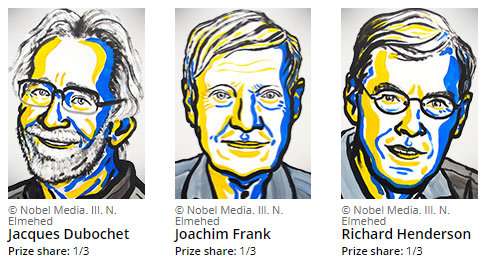
A revolutionary technique dubbed cryo-electron microscopy, which has peered closer at the Zika virus and an Alzheimer's enzyme, earned scientists Jacques Dubochet, Joachim Frank and Richard Henderson the Nobel Chemistry Prize on Wednesday.
Thanks to the international team's "cool method", which uses electron beams to examine the tiniest structures of cells, "researchers can now freeze biomolecules mid-movement and visualise processes they have never previously seen," the Nobel chemistry committee said.
This has been "decisive for both the basic understanding of life's chemistry and for the development of pharmaceuticals," it added.
The ultra-sensitive imaging method allows molecules to be flash-frozen and studied in their natural form, without the need for dyes.
It has laid bare never-before-seen details of the tiny protein machines that run all cells.
"When researchers began to suspect that the Zika virus was causing the epidemic of brain-damaged newborns in Brazil, they turned to cryo-EM (electron microscopy) to visualise the virus," the committee said.
Frank, a 77-year-old German-born American, was woken from his sleep when the committee announced the prize in Stockholm.
"There are so many other discoveries every day, I was in a way speechless," said Frank, a biochemistry professor at Columbia University in New York. "It's wonderful news."
In the first half of the 20th century, biomolecules—proteins, DNA and RNA—were terra incognita on the map of biochemistry.
Because the powerful electron beam destroys biological material, electron microscopes were long thought to be useful only to study dead matter.
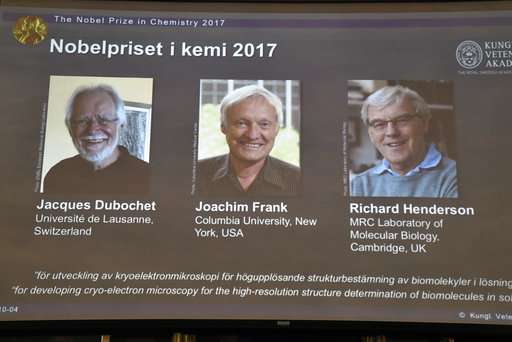
Tea party
But Henderson, a 72-year-old Brit, used an electron microscope in 1990 to generate a three-dimensional image of a protein at atomic resolution, a groundbreaking discovery which proved the technology's potential.
Frank then made it widely usable by developing a method between 1975 and 1986 to transform the electron microscope's fuzzy two-dimensional images into sharp, 3-D composites.
Swiss national Dubochet, added water.
Now 75, he discovered in the 1980s how to cool water so quickly that it solidifies in liquid form around a biological sample, allowing the molecules to retain their natural shape.
The electron microscope's every nut and bolt has been optimised since these discoveries.
The required atomic resolution was reached in 2013, and researchers "can now routinely produce three-dimensional structures of biomolecules," according to the Nobel committee.
"A scientific prize is an ambiguous thing, it highlights an individual when we should highlight a collective effort, but I'm not alone," Dubochet told a news conference in Lausanne after the award announcement.
The honorary biophysics professor was noted not only for his humility, but also his humour.
On his resume, Dubochet notes he was "conceived by optimistic parents" in 1941, and quips that suffering from dyslexia permitted him to be "bad at everything".
The trio will share the prize money of nine million Swedish kronor (around $1.1 million or 943,100 euros).
"Normally what I'd do if I was in Cambridge, we will have a party around tea-time in the lab but I expect we'll have it tomorrow instead," said Henderson, who works at the MRC Laboratory of Molecular Biology.
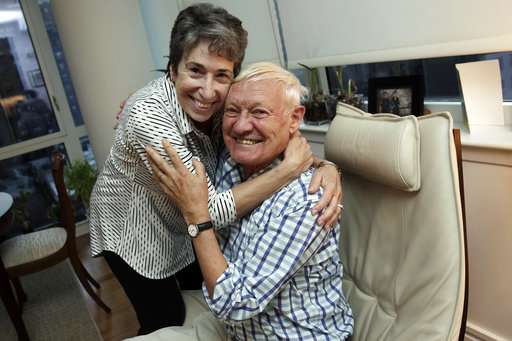
'Resolution revolution'
The announcement was praised by the scientific community and observers around the world.
John Savill, professor and CEO at the UK government-funded Medical Research Council, said electron microscopy has enabled scientists to examine disease molecules up close.
It was used, for example, to compile a detailed identikit of an enzyme implicated in Alzheimer's.
"Determining the structure of proteins in humans is critical to understanding how they interact in the body and developing better drugs for diseases," Savill said in a statement.
Dave Stuart, structural biology professor at Oxford University, described the technique as a "resolution revolution" which has enabled researchers "to see in exquisite detail the structures of life".
It can also be used to examine proteins that kickstart the immune system's attack on intruder viruses.
For John Hardy, a neuroscience professor at University College London, cryo-electron microscopy "opens up the possibility of rational drug design".
"And as a biologist, I can say that the pictures are beautiful," he added.
The Nobel Literature Prize is to be announced on Thursday at 1100 GMT.
***
The Royal Swedish Academy of Sciences has decided to award the Nobel Prize in Chemistry 2017 to
Jacques Dubochet, University of Lausanne, Switzerland
Joachim Frank, Columbia University, New York, USA
and
Richard Henderson, MRC Laboratory of Molecular Biology, Cambridge, UK
"for developing cryo-electron microscopy for the high-resolution structure determination of biomolecules in solution"
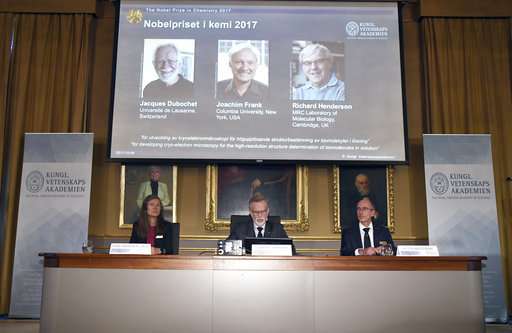
Cool microscope technology revolutionises biochemistry
We may soon have detailed images of life's complex machineries in atomic resolution. The Nobel Prize in Chemistry 2017 is awarded to Jacques Dubochet, Joachim Frank and Richard Henderson for the development of cryo-electron microscopy, which both simplifies and improves the imaging of biomolecules. This method has moved biochemistry into a new era.
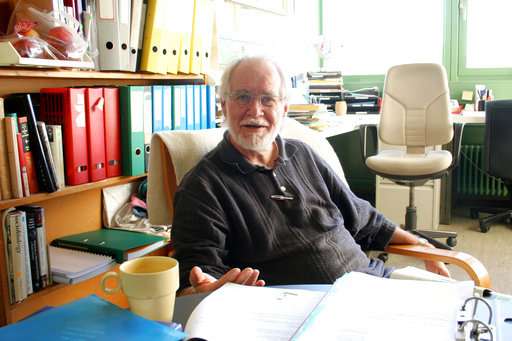
A picture is a key to understanding. Scientific breakthroughs often build upon the successful visualisation of objects invisible to the human eye. However, biochemical maps have long been filled with blank spaces because the available technology has had difficulty generating images of much of life's molecular machinery. Cryo-electron microscopy changes all of this. Researchers can now freeze biomolecules mid-movement and visualise processes they have never previously seen, which is decisive for both the basic understanding of life's chemistry and for the development of pharmaceuticals.
Electron microscopes were long believed to only be suitable for imaging dead matter, because the powerful electron beam destroys biological material. But in 1990, Richard Henderson succeeded in using an electron microscope to generate a three-dimensional image of a protein at atomic resolution. This breakthrough proved the technology's potential.
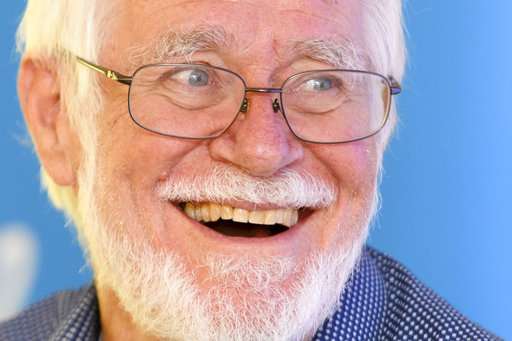
Joachim Frank made the technology generally applicable. Between 1975 and 1986 he developed an image processing method in which the electron microscope's fuzzy twodimensional images are analysed and merged to reveal a sharp three-dimensional structure.
Jacques Dubochet added water to electron microscopy. Liquid water evaporates in the electron microscope's vacuum, which makes the biomolecules collapse. In the early 1980s, Dubochet succeeded in vitrifying water – he cooled water so rapidly that it solidified in its liquid form around a biological sample, allowing the biomolecules to retain their natural shape even in a vacuum.
Following these discoveries, the electron microscope's every nut and bolt have been optimised. The desired atomic resolution was reached in 2013, and researchers can now routinely produce three-dimensional structures of biomolecules. In the past few years, scientific literature has been filled with images of everything from proteins that cause antibiotic resistance, to the surface of the Zika virus. Biochemistry is now facing an explosive development and is all set for an exciting future.
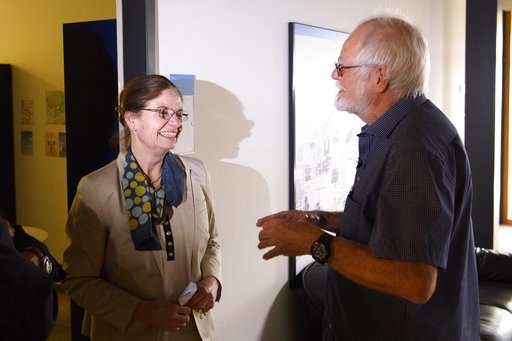
Recent winners of the Nobel Chemistry Prize
Here is a list of Nobel Chemistry Prize winners over the past 10 years, including this year's award on Wednesday to three scientists for the development of cryo-electron microscopy:
2017: Jacques Dubochet (Switzerland), Joachim Frank (US) and Richard Henderson (Britain), for cryo-electron microscopy, a method for imaging tiny, frozen molecules.
2016: Jean-Pierre Sauvage (France), Fraser Stoddart (Britain) and Bernard Feringa (The Netherlands) for developing molecular machines, the world's smallest machines.
2015: Tomas Lindahl (Sweden), Paul Modrich (US) and Aziz Sancar (Turkey-US) for work on how cells repair damaged DNA.
2014: Eric Betzig (US), William Moerner (US) and Stefan Hell (Germany) for the development of super-high-resolution fluorescence microscopy.
2013: Martin Karplus (US-Austria), Michael Levitt (US-Britain) and Arieh Warshel (US-Israel) for devising computer models to simulate chemical processes.
2012: Robert Lefkowitz (US) and Brian Kobilka (US) for studies of G-protein-coupled cell receptors.
2011: Daniel Shechtman (Israel) for the discovery of quasicrystals.
2010: Richard Heck (US) and Ei-ichi Negishi and Akira Suzuki (Japan) for work on palladium-catalysed cross couplings in organic synthesis.
2009: Venkatraman Ramakrishnan and Thomas Steitz (US), Ada Yonath (Israel) for studies of the structure and function of the ribosome molecular machine within cells.
2008: Osamu Shimomura (Japan), Martin Chalfie and Roger Tsien (US) for the discovery and development of the green fluorescent protein, GFP, used as a tracer in lab tests.
More information: www.nobelprize.org/nobel_prize … stry/laureates/2017/
© 2017 The Associated Press. All rights reserved.




















